Zaragoza, Aragón 作者: 来源: 发布时间:2021-03-16
1. Population and Area
Pop: 666,880 (city)
Area: 973,8 km2 (munip.)
Elev: 243 masl
Zaragoza location in Spain within the community of Aragón
https://goo.gl/maps/kuTyzWBkunByULty8
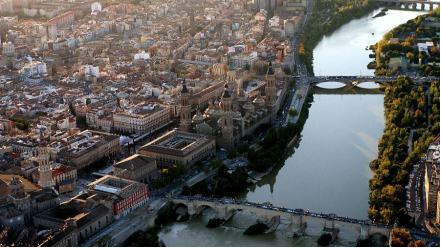
2. Natural geography
Nature and weather
Orography
It sits in the middle of the Ebro valley, on the middle bank of the Ebro, where the Huerva and Gállego rivers flow, which also run through the city.
On the riverside and in the urban area, the terrain is generally flat, especially in the northern part of the city located on the right bank of the mouth of the Gállego river, while the southern part has a more pronounced slope as it moves away del Ebro. The height of the Ebro river as it passes through Zaragoza is 199 m s. n. m., although much of the city is above 210 m a.s.l. and the southern neighborhoods such as Torrero and La Paz, are more than 250 meters above sea level. The bank is surrounded by escarpments, ledges or gullies giving rise to abrupt reliefs, sometimes with steep slopes. In altitudinal contrast with respect to the metropolitan area, within the municipality, the Plana de Muses, a southern segment of the Montes de Castejón at 730 meters of altitude, and the Planas de María above 600 m asl stand out, a result of the hardness of its geological materials to erosion.
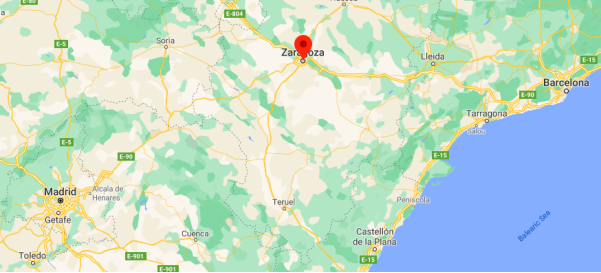
The materials that emerge in the city and its surroundings are fundamentally gravel, sand and clay, product of the sedimentation of the Ebro itself during the Quaternary, which are arranged in river terraces several meters thick on the gypsum and silt units deposited during the Tertiary . These materials are considered evaporites, as they are formed by the evaporation of water in extensive lagoons of an endorheic depression that delimited the Pyrenean, Iberian and Catalan coastal mountain ranges. This endorheic zone was opened to the Mediterranean by the remontant erosion of one or more ravines, precursors of the current Ebro river.
The saline nature of the evaporites, together with a low rainfall and a strong evaporation coefficient, have favored the development of a unique steppe vegetation in the surroundings of Zaragoza, which constitutes a botanical and landscape rarity at European level, although it is little valued in general by its inhabitants. The contrast between this landscape and the exuberant vegetation of the river groves is one of the attractions of the canoe descents that can be made upstream and downstream of the city.
Flora and fauna
Amphibians: common salamander, common spotted toad, southern pintojo toad, runner toad, pyrenean newt.
Birds: european bee-eater, common accentor, booted eagle, common shrike, red-backed shrike, common lark, frieze, mallard, small sandpiper, sapper plane, common bustard, mustachioed, finch, common calandria, European rattle, kestrel Lesser, Partridge Wort, Wren, Plover Plover, Gray Nightjar, Brown Nightjar, Common Quail, Common Cog, Redstart, Gray Wheatear, White Wheatear, Great Cormorant, Black Warbler, Garden Bunting, Common Pheasant, Coot , Little Egret, Cattle or Cattle Egret, Yellow-legged Gull, Laughing Gull, Screech Sparrow, Rook or Rook, Western Wagtail, Common Kingfisher, Red Kite, Myth, Little Owl, Iberian Mosquito Net, European Flybird, Rock Dove, Domestic Pigeon, cerrojillo flycatcher, gray flycatcher, european robin, common rail, common wren, nightingale, little bustard, common terrera, nuthatch, pale swift, green cillo, charlo thrush.
Invertebrates: solenoxyphus lepidus, Eretes sticticus / griseus, Hydrochus ibericus, Ochthebius jaimei, Laccobius moraguesi, Eremopola lenis, Ochthebius notabilis, Nebrioporus sansii, Hygrotus confluens, Ochthebius irenae, Ochthebius jaimei, Laccobius moraguesi, Eremopola lenis, Ochthebius notabilis, Nebrioporus sansii, Hygrotus confluens, Ochthebius irenae, Ortihotylus, Eremopola lenis, Ochthebius helusipomonus, Eremopola lenis, Ochthebius irenarus, Eremopola lenis, Ochthebius salusipomonius, Eremopola lenis Ochthebius grandipennis, Berosus fulvus, Hydraena bisulcata, agabus conspersus (species of coleopteran), agabus didymus, agabus nebulosus, amorphocephala coronata, berosus guttalis, boreonectes ibericus, damselfly, dry mircilx crayfish, European crayfish, cerambiskyus , Dytiscus semisulcatus (species of coleoptera), Elmis maugetii maugetii, Enochrus bicolor, Enochrus halophilus, Diving beetle, Haliplus lineatocollis, Helophorus brevipalpis, Hydraena rufipennis, Hydraena testacea, Hydrobius fuscipes, Hydroporius pubescentus hydroporceus, Hydroporius Castellophilus discreceus, Hydroporus pubestrous meridionalis, laccobius ytenensis, leptopterna pilosa, dragonfly coenagrion scitulum, dragonfly gomphus simillimus simillimus, dragonfly onychogomphus costae, Elizabethan butterfly, mylabris uhagonii, nebrioporus fabressei, noterus clavicornis, noterus laevis, ochthebius subpictus, ochthebius tudmirensis, oulimnius rivularis, paracymus scutellaris, riolus illiesi, saga pedo, scarodytes halensis, stenelmis canaliculata, stictonectes epipleuricus.
Mammals: ibex, deer, bobcat, wild boar, hare, common bat, mountain bat, gray shrew, tricolor or Millet shrew, domestic sheep, common rat, house mouse, field mouse, common badger, vole of goat, fox.
Continental fish: alburno, Cobitis calderoni, Colmilleja, Gambusia holbrooki, European Pike.
Reptiles :collared snake, ladder snake, horseshoe snake, European pond terrapin, cinderella lizard, long-tailed lizard, gecko, pink gecko, nosed viper.
http://www.naturaspain.com/naturaleza-flora-y-fauna-en-la-provincia-zaragoza.html
Köppen Classification: Tropical and Subtropical Steppe Climate
This climate type occurs primarily on the periphery of the true deserts in low-latitude semiarid steppe regions. It is transitional to the tropical wet-dry climate on the equatorward side and to the mediterranean climate on its poleward margin, with a cooler, wetter winter resulting from the higher latitude and mid-latitude frontal cyclone activity. Annual precipitation totals are greater than in tropical and subtropical desert climates. Yearly variations in amount are not as extreme as in the true deserts but are nevertheless large.
The Köppen Climate Classification subtype for this climate is "BSk". (Tropical and Subtropical Steppe Climate).
The average temperature for the year in Zaragoza is 59.0°F (15°C). The warmest month, on average, is July with an average temperature of 76.1°F (24.5°C). The coolest month on average is January, with an average temperature of 43.5°F (6.4°C).
The highest recorded temperature in Zaragoza is 106.0°F (41.1°C), which was recorded in July. The lowest recorded temperature in Zaragoza is 19.0°F (-7.2°C), which was recorded in January.
The average amount of precipitation for the year in Zaragoza is 13.2" (335.3 mm). The month with the most precipitation on average is June with 1.5" (38.1 mm) of precipitation. The month with the least precipitation on average is July with an average of 0.6" (15.2 mm). There is an average of 50.0 days of precipitation, with the most precipitation occurring in May with 6.0 days and the least precipitation occurring in August with 2.0 days.
http://www.weatherbase.com/weather/weather-summary.php3?s=6180&cityname=Zaragoza%2C+Aragon%2C+Spain&units=
Getting there and around
Get there
By plane – 1 Zaragoza Airport (ZAZ IATA) (is 10 km from the city centre). It is a relatively minor airport when it comes to passenger flights, but a major cargo hub seeing the world's largest airplanes land regularly. ZAZ receives regular flights, mostly by budget airlines such as Ryanair and Wizzair. Ryanair flies to its main bases across Europe, including London-Stansted, Bergamo, Beauvais and Charleroi, while Wizzair and several other airlines focus on Romania, where many of the local workers originate from. Other destinations are mostly seasonal flights to holiday destinations in Spain and abroad.
Transfer to/from the airport: The cheapest option is the airport bus 501 stopping at Los Enlaces, Delicias train station, Avenida de Navarra, and Paseo de María Agustín 7, in the city centre (45 minutes ride). The bus costs €1.85 and runs every 30 minutes M-Sa and every hour on Sundays and holidays. Alternatively, a taxi will cost around €25-30 and take around 20 minutes to the city centre.
As Zaragoza Airport has limited flight connections, it can be more convenient to fly to Madrid or Barcelona airports, from where you can reach Zaragoza in less than 3 hours.
From Madrid Barajas Airport: go to Atocha RENFE train station either by taxi (30 minutes, around €25) or by metro (45 min, €2) and then take the high speed train AVE to Zaragoza (1hr 30min, around €50). A cheaper but not so comfortable alternative is taking an ALSA coach that runs between Barajas terminal T4 and Zaragoza every 2–3 hours (3hr 45min trip, single/return: €15/€26). If you are in terminals T1 T2 or T3, take the free airport bus shuttle to terminal T4. The bus to Zaragoza stops in the same place as the airport shuttle. The ALSA ticket counter can be found inside the terminal and a vending machine with ALSA tickets is close to the bus bays.
From Barcelona Airport: The easiest way is to take the half-hourly RENFE R2Nord suburban train to Barcelona Sants (20 min, €2.20), and then take the high speed train AVE to Zaragoza (1hr 45min, around €60). If you already have your AVE ticket, you can get the suburban train ticket for free in the automatic vending machines, by typing the code for “cercanías” that appears in your AVE ticket.
By train – Zaragoza is served by the high speed train AVE that reaches Madrid in approximately 1hr 30 min, and Barcelona in about 1hr 45min. There are up to 19 trains a day in each direction for Madrid and 12 for Barcelona. Regular rates start at about €50 to Madrid and €60 to Barcelona, but you can get up to a 60% discount if you book through the web 15 days in advance.
A cheaper way to get to Zaragoza from Barcelona is using the Regional Express - a slow train going on an ancient track, stopping at every small village and some post-industrial ghost towns, and really astonishing landscapes. The ride takes 5 hours, costs €22.
Other neighbouring cities like Huesca, Teruel, Pamplona, Logroño, Bilbao or Valencia are connected by a few daily conventional trains.
For more information on train schedules and prices, visit the website of RENFE. Note, there isn't a single cafe/bar with wifi in the station.
All trains and buses arrive at 2 Delicias station. Zaragoza-Delicias railway station. The city centre is some 2 km away from, and can be reached using urban buses 34 and 51 or by taxi (10 min, around €10).
By bus – You can reach Zaragoza either from Madrid or Barcelona in 3hr 45min. The coach company is ALSA and the single/return ticket costs around €15/€26. Zaragoza is also well communicated with other main capital cities, such as Valencia and Bilbao. There is possibility of getting to Zaragoza from France by bus. The main lines travel from Lourdes, Tarbes, Pau and Oloron.
For bus schedules from Barcelona, also try Barcelona Nord.
By car -- Zaragoza is very well connected by free speedways with Huesca (1hr), Teruel (2hr), Madrid (3hr), and by toll highways with Barcelona (3hr, €30), Pamplona and Bilbao. Traffic around the city is relatively light except on some weekends and holidays.
Free parking in the city centre is very scarce. Most streets have metered parking limited to 1 or 2 hours. Underground paying parkings are scattered in the entire city and usually have free places.
Distances to Zaragoza: Madrid 312 km, Barcelona 307 km, Bilbao 305 km, Lleida/Lerida 150 km.
Rideshare – Check out Blabla Car's carpooling service for rideshare options. A great option if you don't have a driver's license or want to avoid public transport.
COVID19 – International entry into Spain: partially open
Non-essential travel is open with certain safety requirements. 1.5m social distancing and use of masks are mandatory within Spain.
Some COVID-19 travel conditions may apply in Spain and transport services are subject to change.
Get around
By foot –If you stay in or near the old town, most of the main attractions are within easy walking distance.
By car – Bilbao is difficult to drive in. Hilly one-way streets, and frequent construction projects, make it a nightmare for drivers in parts of the city. Having an automobile map helps a lot; without it allow at least 30min extra to find the right exit from the city. A good idea is to park at the Termibus car park (A-8 Exit 117) and take the tram from San Mamés station to where you want to go.
By bus or train – A transport card costs €7 at any tobacco kiosk (including an initial fee of €2, and credit of €5). With the card you will pay €0,74 for a journey and can change lines within an hour without being charged again. Single tickets bought from the driver are €1.35 (cash only).
Most bus routes have audio announcements, and "next stop" displays inside the vehicle.
There is one tram line ("Tranvía") which runs from the north to the south west, through the city centre. The tram uses the same fare system as the buses - touch your card on a reader when boarding. More tram lines are projected to open soon.
Uber is expanding rapidly across Spain and now offers services in cities across the country. Uber has almost every Spanish city in its network every year, check for availability when you arrive at your destination. Beat, Cabify and Didi are also developing and currently operate in cities including Madrid, Barcelona, Valencia, Valladolid, Murcia, and Bilbao. Check for availability in the city you are visiting.
These services offer people with smartphones a way to book a cab through a mobile app for a pre-agreed price. Fares are comparable with Sitio type cabs, and sometimes trade at a premium to this when local demand increases.
Bicycle – There is a shared bicycle system called Bizi. It has a fairly good website in English which allows you to get a temporary subscription online beforehand. This subscription is valid for three days and costs €5.28. As with most shared bicycle system, the first 30 minutes are free after which you'll pay €0.52 per additional 30 minutes. This is up until 2 hours, after which you'll have to pay a penalty of €3.16 per hour. The deposit is €200.
After getting a temporary subscription online, you receive a subscription number which, together with your pin code of choice, enables you to take a bike immediately upon arrival in Zaragoza. Bike availability is usually good, and there are plenty of stations in the city centre, as well as near the Delicias train station and the expo area.
However, in January 2015, the screens of many bicycle stations were not properly working (broken, unreadable text, flickering). Since this makes it impossible to enter the subscription number and pin code and therefore also impossible to borrow a bike (though it probably still works for annual subscribers who have a contactless card), the system becomes somewhat unreliable.
3. GDP
GDP: 135,987 M USD (2015)
4. Industry characteristics
Zaragoza is the fifth city in Spain according to its Economic Activity Index.The strategic sectors of the Zaragoza economy are the automobile industry, logistics and transport, renewable energy, business services, agro-industry and tourism.
An Opel factory was opened in 1982 in Figueruelas, a small village nearby. The automotive industry is a main pillar of the regional economy along with Balay, which manufactures household appliances; CAF, which builds railway rolling stock for both the national and international markets; SAICA and Torraspapel in the stationery sector; and various other local companies, such as Pikolin, Lacasa, and Imaginarium SA.
In the industrial field also stand out:
·Appliances: BSH (Bosch, Siemens, Balay)
·Food / drink: Supermercados Sabeco, Chocolates Lacasa, Rivasam Intercontinental S.A, La Zaragozana
·Automobiles: Opel España S.A
·Textile products: Adidas España S.A
·Paper and cardboard: Industrias Celulosa Aragonesa S.A y Torraspapel S.A
·Mattresses: Pikolin
·Trailers: LeciTrailer and Schmitz Cargobull
·Lifting machinery: Schindler.
The city's economy benefited from projects like the Expo 2008, the official World's Fair, whose theme was water and sustainable development, held between 14 June and 14 September 2008, Plataforma Logística de Zaragoza (PLAZA), and the Parque Tecnológico de Reciclado (PTR). Furthermore, since December 2003, it has been a city through which the AVE high-speed rail travels. Currently, Zaragoza Airport is a major cargo hub in the Iberian Peninsula, behind only Madrid, Barcelona, and Lisbon.
The transport of goods at Zaragoza airport stands out, which in 2017 loaded 117,000,000 kg, making it the third Spanish airport (in terms of goods) only behind Madrid and competing for second place with Barcelona.
Projects such as the Zaragoza Logistics Platform (PLAZA), which with 12,500,000 m² is the largest in southern Europe, have boosted the logistics sector in recent years. In addition, the opening of Puerto Venecia, the largest shopping center in Europe, has created about 4,000 jobs, being an important national and international tourist center.
These kinds of commercial initiatives are joined by others that stimulate the establishment of offices in the city, such as the World Trade Center Zaragoza building or the space for the 2008 International Exposition, converted into a business complex and the City of Justice .
Zaragoza is home to a Spanish Air Force base, which was shared with the U.S. Air Force until 1994. In English, the base was known as Zaragoza Air Base. The Spanish Air Force maintained a McDonnell Douglas F/A-18 Hornet wing at the base. No American flying wings (with the exception of a few KC-135's) were permanently based there, but it served as a training base for American fighter squadrons across Europe. It also hosts the main Spanish Army academy, Academia General Militar, a number of brigades at San Gregorio, and other garrisons.
Key project: Zaragoza projects for the future
In the hard times of the pandemic, which has frustrated so many business projects and investments, Zaragoza clings to a range of strategic projects, both public and private, with which it intends to reactivate the economy and employment. Trade, innovation, housing and rehabilitation policies, logistics or energy are some of the bets of a city that aspires to rise from a crisis that has plummeted the Gross Domestic Product (GDP) and has plunged uncertainty into the citizens.
Housing and rehabilitation of degraded spaces
The health and economic crisis has reactivated the interest of the administrations to encourage housing rehabilitation policies, a sector that allows environmental improvements, tidies up the situation of degraded neighborhoods and generates employment, especially in small and medium-sized construction companies. For the moment, the Zaragoza City Council has increased this year's budget for rehabilitation aid, which will reach 6.8 million euros (with private contributions, the investment rises to 18.6).
It will benefit 1,191 homes. On the other hand, the deadline for requesting aid from the Urban Regeneration and Renovation Area (ARRU) has just opened, which has 3.2 million euros. These funds will especially benefit the area around Pignatelli Street, which is awaiting a special plan to revitalize the sector and which will be presented in the coming weeks.
Recovery of the heritage of the Aragonese capital
Among the projects that are moving in the City Council in recent times are those of recovery of some listed buildings. For example, on October 15, the keys to 26 homes that have been built in the old Blasco Printing House will be delivered. But it is not the only property pending rehabilitation. The Town Hall has just cleaned up part of the old Giesa factory in the Las Fuentes neighborhood (in the image), where it wants to start investing progressively to turn it into a space with cultural and neighborhood uses. And within the framework of the Pignatelli special plan, another emblematic building awaits restoration: the old Pontoneros building, in a serious state of degradation, which the Zaragoza City Council wants to transform into a university residence and engine of the neighborhood.
Renewable energies, a strategic sector for the future
The renewable energy sector is one of the most developed in Aragon in recent years, but more in the territory than in the capital. The municipal government PP-Cs wants to promote wind and photovoltaic parks in the surroundings of the city with which to formalize a power purchase agreement after the corresponding public tender. The goal is for the City Council to save around 30% of its energy consumption, which would mean about 6 million euros. The project is delayed, but it is planned to reactivate it after the end of the current energy contract this year.
https://www.heraldo.es/noticias/aragon/zaragoza/2020/10/12/zaragoza-se-aferra-a-sus-proyectos-de-futuro-para-plantar-cara-a-la-crisis-1399695.html
5. Attractions
Zaragoza’s Roman Wall
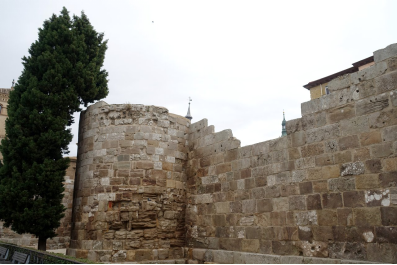
Caesaraugusta was founded in the year 14 BC. Recent archaeological studies reveal that the city did not have a Wall of protection since its establishment, they had the east natural barrier formed by the river Huerva.
It is believed that Caesaraugusta’s Roman Wall was built in the second half of the third century. It was up 3,000 meters lenght and ran the present streets of César Augusto, Coso and Echegaray y Caballero.
The Wall also had about 120 semicircular defensive towers that were placed every 14-16 meters. The construction is executed with a uniform technique: with internal body opus caementium (Roman concrete) and blocks coated outside of seven meters thick except in the eastern section, which was 6 meters thick .
Research shows that the Wall was 10 meters height and a 4 meters width. It had four gates, one at each end of the main streets: the Cardo Maximus (approximately followed the course of the present street Don Jaime I) and Maximum Decuman (that ran what today are streets Mayor, Espoz and Mina and Demonstration).
The Roman Wall was exploited for defensive purposes in later centuries by Visigoths and Muslims, and conditioned the urban trace for centuries.
Nowadays, there are preserved twot sections of the Wall. The longest is about 80 meters and is located next to Torreón de la Zuda, at César Augusto Avenue. The other is located at the bottom of the Convent of the Holy Sepulchre in Coso Street and Echegaray y Caballero.
In 1933 the Roman Wall of Zaragoza was declared a National Monument.
http://blog.zaragozaturismo.es/en/2013/06/26/zaragoza-roman-past-the-wall
Aljafería
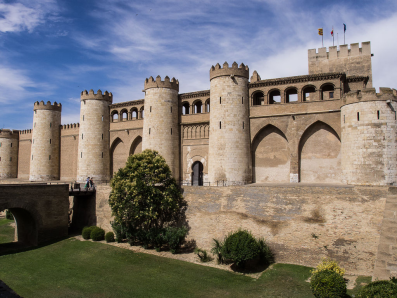
The Aljafería Palace is a fortified medieval palace built during the second half of the 11th century in the Taifa of Zaragoza in Al-Andalus, present day Zaragoza, Aragon, Spain. It was the residence of the Banu Hud dynasty during the era of Abu Jaffar Al-Muqtadir. The palace reflects the splendour attained by the Taifa of Zaragoza at the height of its grandeur. It currently contains the Cortes (regional parliament) of the autonomous community of Aragon.
The structure holds unique importance in that it is the only conserved testimony of a large building of Spanish Islamic architecture of the era of the Taifas (independent kingdoms). The Aljaferia, along with the Mosque–Cathedral of Córdoba and the Alhambra are the three best examples of Hispano-Muslim architecture and have special legal protection. In 2001, the original restored structures of the Aljafería were included in the Mudéjar Architecture of Aragon, a World Heritage Site.
The solutions adopted in the ornamentation of the Aljafería, such as the use of mixtilinear arcs and springers, the extension of arabesque in large area, and the schematisation and progressive abstraction of the yeserias of a vegetal nature, decisively influenced Almoravid and Almohad art in the Iberian Peninsula. The transition of the decoration towards more geometric motifs is at the basis of Nasrid art.
Cathedral-Basilica of Our Lady of the Pillar
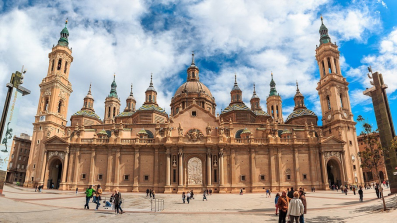
The Basilica venerates Blessed Virgin Mary, under her title Our Lady of the Pillar praised as "Mother of the Hispanic Peoples" by Pope John Paul II. It is reputed to be the first church dedicated to Mary in history.
Local traditions take the history of this basilica to the dawn of Christianity in Spain attributing to an apparition to Saint James the Great, the apostle who is believed by tradition to have brought Christianity to the country. This is the only reported apparition of Mary to have occurred before her believed Assumption.
Many of the kings of Spain, many other foreign rulers and saints have paid their devotion before this statue of Mary. Saint John of the Cross, Saint Teresa of Ávila, Saint Ignatius of Loyola, and Blessed William Joseph Chaminade are among the foremost ones. The Basilica of Our Lady of the Pillar is one of two minor basilicas in the city of Zaragoza, and is co-cathedral of the city alongside the nearby La Seo de Zaragoza. The architecture is of Baroque style, and the present building was predominantly built between 1681 and 1872.

MY FAVOURITE PLACES IN ZARAGOZA, SPAIN! - Zaragoza Vlog
https://youtu.be/L16FajWA2nc
6. History
Roman Caesaraugusta
The Sedetani, a tribe of ancient Iberians, populated a village called Salduie [es] (Salduba in Roman sources). Later on, Augustus founded a city called Caesaraugusta[7] at the same location to settle army veterans from the Cantabrian wars. The foundation date of Caesaraugusta has not been set with exact precision, though it is known to lie between 25 BC and 11 BC.
Middle ages
The city did not suffer any decline during the last centuries of the Roman empire and was captured peacefully by the Goths in the fifth century AD.
In the 8th century, following the Umayyad conquest of the Iberian Peninsula, Zaragoza became the capital of the Upper March of al-Andalus.
In 1018, amid the collapse of the Caliphate of Córdoba, Zaragoza became an independent taifa kingdom controlled by the Tujibid family. Ruled by the Banu Hud since 1039, the taifa greatly prospered in a cultural and political sense in the late 11th century, governed by Ahmad al-Muqtadir, Yusuf al-Mu'taman ibn Hud and Al-Musta'in II. It fell to the Almoravids in 1110.
On 18 December 1118, Alfonso I of Aragon conquered the city from the Almoravids, and made it the capital of the Kingdom of Aragon. After Alfonso's death without heirs in 1134, Zaragoza was swiftly occupied by Alfonso VII of León. The city control was held by García Ramírez, king of Navarra, until 1136 when it was given to Ramiro II the Monk in the treaty signed at the betrothal of Ramiro's daughter Petronila and Alfonso's son Sancho. The wedding never happened, as Petronila ended up marrying Ramon Berenguer IV, Count of Barcelona.[citation needed] The marriage union was the origin of the Crown of Aragón, and union with Castile would not happen for another 333 years, when King Ferdinand II of Aragon and his wife, Queen Isabella I of Castile, each took their respective thrones.
13th century Zaragoza was the scene of two controversial martyrdoms related with the Spanish Inquisition:[clarification needed] those of Saint Dominguito del Val, a choirboy in the basilica, and Pedro de Arbués, head official of the inquisition. While the reality of the existence of Dominguito del Val is questioned, his "murder" at the hands of "jealous Jews" was used as an excuse to murder or convert the Jewish population of Zaragoza.
Early Modern history
An outbreak of bubonic plague decimated the city in 1564. It reportedly killed about 10,000 people out of an estimated population of 25–30,000.
In the context of the 1701–1714 War of Spanish Succession, the city rose in arms in favour of the Archduke Charles, who was proclaimed "King of Aragon" in the city on 29 June 1706, following the uprising of other parts of the Kingdom of Aragon in December 1705. Charles entered the city in July 1706, directing the attack on those places of Aragon that had sided with the Bourbon faction such as Borja or the Cinco Villas. Following the April 1707 battle at Almansa, the tide turned with the Austracist forces fleeing in disarray, and the Bourbon forces commanded by the Duke of Orléans entering the city on 26 May 1707. As he seized control of the kingdom, he began to enact the series of institutional reforms known as the Nueva Planta, abolishing the Aragonese institutions in favour of the Castilian ones. The war turned around again in 1710 after the Battle of Almenar, and, following another Bourbon defeat near Zaragoza on 20 August 1710, Archduke Charles returned to the city on the next day. This was for only a brief period, though, as following the entry of Philip V in Madrid and the ensuing Battle of Villaviciosa in December 1710, the Habsburg armies fled from Zaragoza in haste in December 1710 and Philip V proceeded to consolidate his rule over the kingdom of Aragon, resuming administrative reforms after a period of institutional void.
An important food riot caused by the high price of bread and other necessity goods took place in the city in April 1766, the so-called motín de los broqueleros, named after the repressive agents, volunteer farmers and craftsmen who wielded swords and bucklers (broqueles). The repression left about 300 wounded, 200 detainees and 8 deaths and it was followed by 17 public executions, and an indeterminate number of killings at the dungeons of the Aljafería.
Late Modern history
Zaragoza suffered two famous sieges during the Peninsular War against the Napoleonic army: a first from June to August 1808; and a second from December 1808 to February 1809, surrendering only after some 50,000 defenders had died.
Railway transport arrived to Zaragoza on 16 September 1861 via the inauguration of the Barcelona–Zaragoza line with the arrival of a train from the former city to the Estación del Norte. The opening of the Madrid–Zaragoza line took place a year and a half later, on 16 May 1863.
The July 1936 coup d'état (with Gral. Miguel Cabanellas, Col. Monasterio, Urrutia, Sueiro, Major Cebollero and Gral. Gregorio de Benito at the centre of the Mola-led conspiration in Zaragoza) triumphed in the city. The military uprising in Africa on 17 July was followed in the early morning of 19 July by the military command, easily attaining their objectives in Zaragoza, despite the latter's status as stronghold of mobilised labour (most of them CNT anarcho-syndicalists but also UGT trade unionists), as the civil governor critically refused to give weapons to the people in time. Many refugees, including members of the provincial committees of parties and unions, would flee to Caspe, the capital of the territory of Aragon, which was still controlled by the Republic.
The rearguard violence committed by the putschists, with already at least 12 murders on 19 July, would only go in crescendo along the beginning of the conflict. Thus one of the two big cities under Rebel control since the early stages of the Spanish Civil War along Seville, Zaragoza profited from an increasing industrial production vis-à-vis the war economy, playing a key role for the Francoist faction as ammunition manufacturer.
The General Military Academy, a higher training center of the Spanish Army, was re-established on 27 September 1940 by José Enrique Varela, the Francoist Minister of the Army.
The 1953 Accords ensued with the installment of a joint US–Spain air base in Zaragoza.
Following the declaration of Zaragoza as Polo de Desarrollo Industrial ("Pole for Industrial Development") by the regime in 1964, the city doubled in population in a short time. The increase in population ran parallel to the rural flight and depopulation in the rest of Aragon.
In 1979, the Hotel Corona de Aragón fire killed at least 80. The armed Basque nationalist and separatist organization ETA has been blamed, but officially the fire is still regarded as accidental. ETA carried out the Zaragoza barracks bombing in 1987 which killed eleven people, including a number of children, leading to 250,000 people taking part in demonstrations in the city.
Since 1982, the city has been home to a large factory built by General Motors for the production of Opel cars, some of which are exported to the United Kingdom and sold under the Vauxhall brand. The city took advantage of the entry of Spain into the European Communities (later European Union).
7. Contact Information
City Mayor: Jorge Azcón Navarro
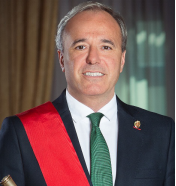
Phone number: +34 (976) 721 100
Facebook: https://www.facebook.com/JorgeAzcon
Instagram: https://www.instagram.com/jorgeazcon
E-mail: jazcon@zaragoza.es
Website: https://www.zaragoza.es
Govt. Office Address: Plaza Ntra. Sra. del Pilar, 18, 50003, Zaragoza, Spain
